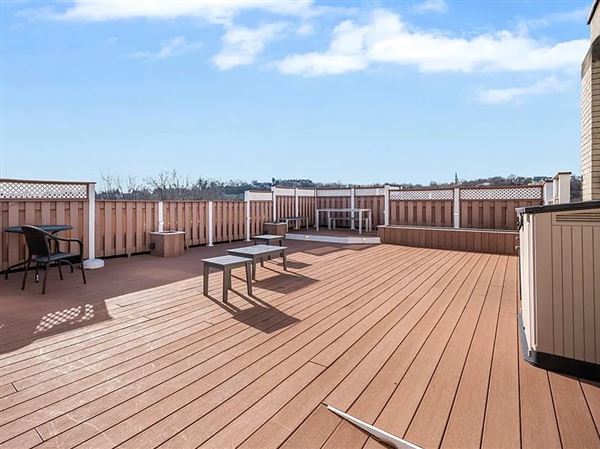Rachael Wonderlin, 28, is a gerontologist and dementia care consultant who has been a staff member specializing in care of those with diseases causing memory impairment in three long-term care settings in North Carolina and the Pittsburgh area.

The Mount Washington resident authors a blog at www.dementia-by-day.com and had a book, “When Someone You Know is Living in a Dementia Care Community,” published last year by Johns Hopkins University Press. She has a bachelor’s degree in psychology from the University of Mary Washington and a master’s in gerontology from the University of North Carolina-Greensboro.
Ms. Wonderlin is hired by facilities to train their staff who deal with dementia patients. She also makes speaking experiences about the care of those with Alzheimer’s disease and related memory disorders. Ms. Wonderlin will be speaking and answering questions for the public from 2:30 to 4 p.m. on Saturday, April 8, at the Downtown branch of Carnegie Library, 612 Smithfield St. She can be reached at rachaelwonderlin@gmail.com.
Aging Edge sought Ms. Wonderlin’s advice on various topics encountered by family members and paid staff dealing with cognitively impaired individuals. The interview has been edited for brevity and clarity.
Aging Edge: A lot of professionals in the dementia field have some personal experience with a relative that helps explain their interest in it. Was that the case for you, or what led you to focus on this specialty?
Wonderlin: Surprisingly, no. I was very fortunate to have two wonderful sets of grandparents I spent a lot of time with when younger, because both my parents were working. I was always interested in how the brain works, and I really liked hanging out with older people. In high school, a friend and I started volunteering in a skilled nursing facility, and I really liked it. I knew I wanted to work with older adults, but it wasn’t until college that I started defining what that meant, by learning what it meant to work in gerontology.
Aging Edge: So how did you learn the ins and out of dementia care?
Wonderlin: I read any book I could get my hands on, joined a lot of online communities and learned in classes, but most of it is just from experience. My first job in dementia care was in North Carolina as memory program director in a senior living community, and I worked hands-on with a ton of people. I started a blog to tell stories about the people I got to know with dementia and found a lot of people really connected with that. They loved hearing positive stories, because people don’t realize there are beautiful moments in dementia. A lot of stories are really happy or funny.
Aging Edge: What would be a good example of that?
Wonderlin: My favorite person I took care, a lady named Dot in her late 90s in North Carolina. She loved her roommates and liked where she lived and just really enjoyed life, living each moment in a way that other people can’t. People without dementia are constantly thinking about tomorrow and what’s going to happen next, but someone like Dot could love doing puzzles over and over, when many of us would just get tired of it. They were always enjoyable to her, and she just really enjoyed life. She was one of the most pleasant people I’d ever met.
Aging Edge: Let’s say that rather than in an institution of some sort, a family member is still caring for an individual with dementia at home. What’s the most important advice you could give them?
Wonderlin: The best thing is to embrace the reality of the person they’re caring for, to really try to get into their world rather than drag them back into ours. Dot, for instance, thought her husband was still alive when he wasn’t, but she lived in her own world thinking that, which was nice for her — it was much more positive. Sometimes the dementia world is much happier than our world, because the reality is whatever they want it to be. I tell caregivers to be OK with the fact that their world might not be the same as ours — don’t get into an argument over it, because communication is way better when you aren’t arguing with that person who has dementia.
Aging Edge: When would you say is the appropriate time for a family caregiver to consider placing their loved one in a facility of some sort?
Wonderlin: There’s no exact answer, because everyone has an individual situation. When a family starts to think about it, saying “Hmm, maybe we ought to think about long-term care,” then maybe that’s the right time to do something. A lot of families wait too long. They feel bad, they feel guilty about putting someone in a home, and then you end up moving that person when it’s kind of late in the game, past the point of their being able to take pleasure in activities and other people.
Aging Edge: Once it’s time, how should people go about evaluating the best dementia care setting for someone they care about?
Wonderlin: The best way is to check out a list of the community settings around you and just go and see them — just like when I was picking out a university to attend, I would go and see the campuses, and when I visited one I liked, I just got a gut feeling that this is a good place. No place in long-term care is going to be perfect, but you want a gut feeling that it’s a comfortable place, that the staff is engaging positively, that there’s a good calendar of activities. A lot of places even let you have a free meal, so bring your loved one to lunch there as an outing and just see how it goes, looking at people living there and how the staff responds to them. You don’t even have to tell your loved one it’s a dementia care facility — just say we’re going out for lunch at a place.
Aging Edge: If it’s the right place for someone with Alzheimer’s or other dementia, what should visitors be able to notice on a walk-through?
Wonderlin: There should be things for residents to interact with and recognize. My favorite thing is a nursery area, like having a crib with baby dolls that can be held by people with dementia as though they’re babies. There should be something like a tool area, where people can pick things up. There should be shadow boxes outside of rooms, where there are pictures of people when younger and personal trinkets of theirs to recognize. The activities calendar should be different from other places caring for older adults, because with something like bingo, a lot of already confused residents would have trouble with it. There should be hands-on activities for them — folding towels, making floral arrangements, easy painting — and a snack program, because people with dementia won’t eat unless you hand them something.
Aging Edge: Is music important?
Wonderlin: It’s incredibly important. There should be something playing when you walk into the facility — something from their era, maybe from the 1950s like Frank Sinatra or Dean Martin or Elvis Presley. Just playing this in the background makes a big difference in everyone’s mood. A lot of residents will get up and sing or dance or gravitate toward the music.
Aging Edge: When comparing places, how should you evaluate the staff?
Wonderlin: For me, it would be how they’re interacting with residents. Are they smiling, or are they getting annoyed with them? Are they holding their hand to take them places, or are they grabbing them to take them to the bathroom? It can be tough and tiring to deal with people with dementia all day, but you want to see a staff that’s clearly happy and enjoys the residents as human beings — they know the residents and what they like, they know the families. If you’re taking a tour, find out from family members of the residents there what they think of the staff and their communication.
Aging Edge: Once you make a choice of a facility, what’s the right role for that family member who’s no longer a 24/7 caregiver? How involved should they remain?
Wonderlin: It’s important to set a visiting schedule, maybe going a few times a week, especially earlier in the day, because a lot of people with dementia have sundowning, where people get more upset in the afternoon. Stop in with a purpose, like to bring in homemade cookies or to take them out for lunch or ice cream, and stay for a while and then leave. A lot of people feel so guilty that they think they have to go in every day, but a lot of the reason to put the person in a care community is so that you’re not the 100 percent full-time caregiver any more, so you can go back to also managing your own life.
Aging Edge: How do you get the person with dementia to adjust to the new setting? It’s often said that such individuals have particular difficulty with disruptions and change.
Wonderlin: I think the biggest thing is not to tell the person they’re moving there permanently. A lot of people make that mistake, saying, “Mom, we’re moving you because you have a memory problem,” which immediately gets people on the defensive. You can instead tell them they’re just moving in for a little bit to get their blood pressure in check, or to get help with their arthritis.
Aging Edge: So use white lies to help people manage the adjustment?
Wonderlin: I tell people to take the word “lying” and throw it out of your vocabulary. If we’re talking about getting into their world, you’re not lying but engaging on their level. It’s possible to give them way too much information. Just say “You’re going to stay here for a little bit,” and don’t put a time constraint on it, and if you need to you can blame it on other people, like “The doctor thinks it’d be good for you to stay here for a little while.” It’s much easier for a person to be mad at their doctor than to have the blame put on you.
Aging Edge: If you’re consulting for a facility that provides dementia care, they presumably have already provided some specialized training to their staff, so what’s there for you to tell them that they don’t know?
Wonderlin: Honestly, a lot of people who work at these communities do not know that much about dementia, at least not the finer points of communication and how to deal with certain situations. I go into a lot of discussion on how to communicate, how to bring somebody with dementia into the shower, how to toilet somebody. These are all easy things when someone doesn’t have cognitive impairments, but if you have dementia these can be scary. People who are scared can get combative, and one of the biggest things is getting staff to embrace that person’s reality, get in their world and understand what they perceive.
Aging Edge: You’ve described some of the ideal features and staff techniques of a place offering quality dementia care. How close do facilities you’re aware of in the Pittsburgh area come to meeting those qualities?
Wonderlin: I think it varies widely from place to place. Overwhelmingly, places are not really prepared to offer dementia care. They’re getting better, but there’s still a long way to go in trying to become more dementia-friendly, with goal-oriented activities. Some places don’t really know what to do beyond putting up pictures from the 1950s and shadow boxes of the residents with a photo outside their door. You need some boots-on-the-ground people who know what to do, or sometimes it takes a consultant like me to go in and offer ideas.
Aging Edge: What kind of problems would you spot and what kind of recommendations might you make?
Wonderlin: If a place is not making the environment very dementia-friendly, there might be no music, no activity calendar, no snack program or the right lighting or setup. At one place, one of things I helped do was revamp the look of their dementia care unit. It had a big nursing station, but I helped them make it look like a five-and-dime soda fountain counter. Instead of looking like a place where you would get medicine, it looked like where you would get a milk shake, and we had ice cream and snacks back there. We brought in a piano to the unit, because a lot of people who once played the piano still can. We added a nursery with baby dolls, and a man cave that looked like a cabin where residents could go to hang out.
Aging Edge: And should family members feel secure that such places can do better for their loved ones than they can at home?
Wonderlin: People with dementia need to be able to engage with others at their level. If they’re at home forever, they’re not around others with dementia and don’t get to interact with others at their level — to do activities and hear music in a community setting. At home, you can’t provide the amount of stimulation that goes on in a senior care community, with the sheer number of people around. People will say “You ought to keep taking care of your mom at home,” but that’s a terrible thing to say, because everyone has a different situation. I don’t recommend taking care of somebody at their house forever — it’s not good for the person with dementia or for the family.
Gary Rotstein: grotstein@post-gazette.com or 412-263-1255.
First Published: February 28, 2017, 5:20 p.m.
















